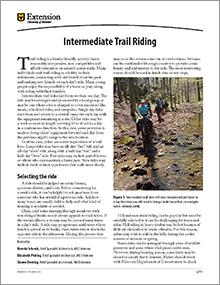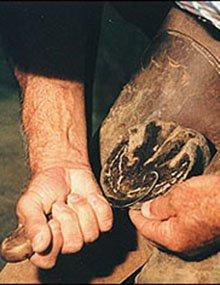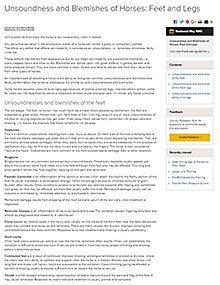Meta description: Explore a range of equine-related publications, covering topics such as horse care, training, safety, and more for equine enthusiasts.
The following publications cover topics related to Equine Extension. For a complete list of MU Extension publications, visit the main Publications page.
Intermediate Trail Riding
Revised
Intermediate trail rides last for more than one day. Learn how to prepare riders, horses, equipment and more to safely enjoy scenic nature trails.
Trail Riding Checklist
New
One of the most important things for trail riding is to make sure you know what to bring for people, horses and camping. Use this checklist to help pack for trail rides of all kinds.
Community Pleasure Trail Riding
Revised
Missouri has many scenic and challenging trails for riders. Many areas with streams, rivers, hills and trees have numerous trails on which local groups can ride.
Haltering and Tying Horses
Revised
Halters are designed to help catch, hold, lead and tie horses and ponies. A rider may choose to have a specific halter for each horse, or they can select one of the correct size and adjust it to fit any horse.
Buying a Horse
Revised
Carefully plan your horse purchase with tips on budgeting, selecting, and evaluating horses, and ensuring long-term success in horse ownership.
Practical Horse Psychology
Revised
Splints in Horses
Revised
Learn about splint bone conditions in horses, their causes, symptoms, and treatments for better care and management.
Feeding Horses
Revised
Learn the essentials of feeding horses, including roughage and concentrate recommendations, nutrient needs, and feeding tips for health and performance.
Safe Ground Handling of Horses
Revised
During the last decade, participation in horse-related activities has continued to grow. The National Safety Council estimates that more than 10 million people in the United States are involved in equine sports. Membership in many horse associations has grown steadily.
Horses — Conformation: Form to Function
Revised
Proper horse conformation affects performance and health. Learn how balance, muscle structure, and movement impact a horse’s abilities in various activities.
Saddling, Bridling and Riding the Western Horse
Reviewed
Learn essential techniques for safely saddling, bridling, and riding Western horses, ensuring proper equipment use and understanding horse behavior.
Choosing, Assembling and Using Bridles
Revised
Bridles are used to control horses and achieve desired performance. Although horses can be worked without them or with substitutes, a bridle with one or two bits can add extra finesse. The bridle allows you to communicate and control your mount.
Horse Breeding Arithmetic: 2 + 2 = 1
Reviewed
Explore factors influencing equine breeding success, including mare physiology, estrus cycles, and management practices to improve foaling rates.
Navicular Disease in Horses
Revised
Navicular disease is a common cause of lameness in horses, often leading to inflammation and tendon damage in the forefeet.
Tall Fescue Toxicosis
New
Tall fescue is Missouri's most widely used forage crop. Visit our site to learn about Tall Fescue Toxicosis.
Functional Anatomy of the Horse Foot
Reviewed
A horse’s hoof is composed of the wall, sole and frog. Read this guide to learn more about the functional anatomy of the horse foot.
Care of Your Horse’s Feet
Reviewed
Foot care is one of the most neglected horse management practices. Most lameness that impairs the usefulness of a horse can be prevented by proper foot care and reasonable management.
Foot care should be as routine as feeding and watering. It should include:
Determining Age of Horses by Their Teeth
Reviewed
The art of determining the age of horses by inspection of teeth is an old one. Visit our website to learn about determining age of horses by their teeth.
Longe Line Training
Reviewed
Longeing is a procedure in which the horse travels in a large circle around the handler on a long strap or line.
Unsoundness and Blemishes of Horses: Feet and Legs
Reviewed
Any abnormal deviation in the structure or action of a horse can render it partly or completely useless. Visit our website today to learn more.

Feeds for Light Horses
Reviewed
Learn how to feed light horses efficiently by choosing the right balance of grains, roughages, and supplements to maintain their health and minimize costs.

Unsoundness and Blemishes of Horses: Head, Body, Respiratory Tract and Stable Vices
Reviewed
Any defect that affects serviceability is considered an unsoundness. A defect that detracts from appearance but does not impair serviceability is considered a blemish.
Health Hints for Your Horse
Reviewed
Learn about common ailments and injuries in horses, so you can prevent problems and ride more.





















